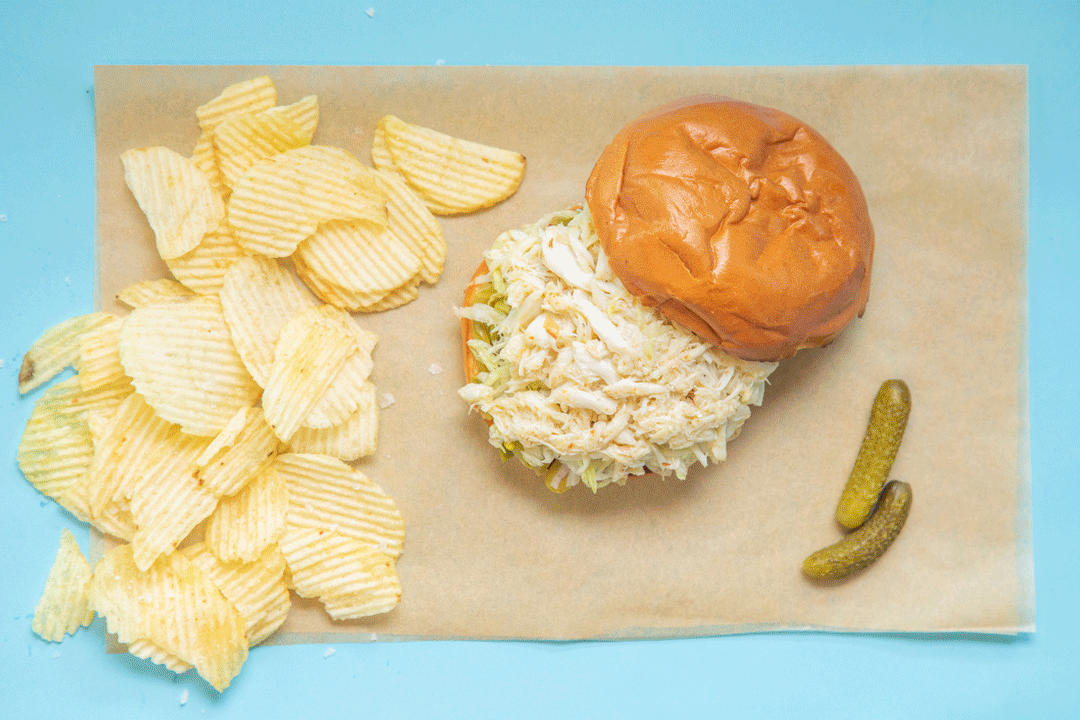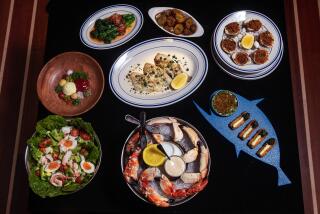A Guide to Shellfish
- Share via
Knowing your crustaceans does not sound like such a hard job. Even the most unsophisticated among us can recognize a lobster and have eaten their share of shrimp or crab.
Once past the big three, though, the waters get considerably murkier. The sheer number of crustaceans--there are 4,400 species of edible crabs alone--makes things difficult. Just ask the blue-crab-loving Marylander who visits Seattle--where the large Dungeness is the crab of choice--and requests “a dozen crabs.”
What follows is a guide to a few of the types of crustaceans you might encounter at a seafood market or on a restaurant menu:
* CRABS--They range from pea-sized to 12 feet wide, live in all sorts of waters, in all sorts of climates, on all continents. Some of the most avid crab-lovers live in Asia, and if you think crabs are getting expensive in the United States, consider that in China (according to the “China the Beautiful Cookbook”), connoisseurs will pay up to $100 for a five-inch Shanghai hairy crab.
In the United States, many types of crab are eaten; four of these are commercially important. In the lead is the blue crab, caught in eastern waters from Chesapeake Bay in Maryland to the Gulf of Mexico.
King crabs, whose lanky legs turn up in some restaurants ready to be cracked open and dipped in melted butter, are also available frozen. Buyers must beware, though: Much of the crab that parades under that label is not crab at all, but surimi, a paste made of fish and flavorings textured and colored to look like king crab.
Stone crabs, which are something of a cult in Florida and other areas close to the Gulf, are among the neatest of crabs to eat, because only the claw is consumed. When fisherman catch stone crabs they break off one claw and throw the crab back into the water, where it grows another. The season for fresh stone crab claws is short December to February.
* CRAWFISH--Before refrigeration, people who lived inland never got the chance to taste many crustaceans because they spoil so quickly. But even those who had never tasted lobster or shrimp were usually familiar with the crawfish, a freshwater shellfish that resembles a miniature lobster only a few inches long.
Crawfish are found in streams, ponds and ditches on every continent except Africa. They are particularly popular among the French. The unofficial world capital of crawfish eating is Nantua; a dish prepared a la Nantua is garnished with crawfish or napped with crawfish sauce. The French mania for ecrevisses peaked in the mid- to late 19th Century, when the formerly inexpensive shellfish became a costly delicacy for wealthy epicures. During that time the crawfish also earned a reputation for its supposedly aphrodisiac qualities. Waverly Root says that an invitation to a meal of crawfish was the equivalent of a later age’s “Come up and see my etchings.”
While American crawfish, or crayfish, can be found deep into the Midwest, they are most often associated with the bayou country of Louisiana, where they are harvested in winter and spring. The tails are eaten, and sometimes, if the beast is big enough, so are the claws.
* LOBSTER--The American lobster, Homarus americanus , is considerably more American than apple pie. New England settlers in the 17th Century reported finding lobsters up to six feet long. Ironically, they were not prized in those early years, but were considered fit only for peasants.
There are other lobsters in Atlantic waters, such as the European lobsters that thrive off the coast of Brittany, Britain and Scandinavia. Other parts of the world, even warm southern waters, have creatures they call lobsters, although they are different crustaceans.
Lobsters taste best when they are eaten within sight of the sea, and when they perish in the same element in which they lived. They begin to die and lose flavor the moment they are taken from the water, so if they can be popped right from the lobster pot into the kitchen pot they provide the most taste thrills. That is why you will get a sweeter lobster from a no-frills little “lobster pound” on the Maine coast than from the priciest restaurant in New York.
* SPINY OR ROCK LOBSTER-- Palinurus vulgaris lacks the imposing claws of Homarus , but it manages to get along without them. Its enemies are suitably intimidated by its spiky carapace and horror-movie appearance, and dedicated eaters are mollified by the wealth of delicious meat in its broad tail.
In France, the spiny lobster is known as the langouste (which means locust, in reference to the beast’s bug-like looks). Don’t confuse it with the langoustine , though, a different crustacean altogether (see scampi, below).
* SCAMPI--The scampi is actually a small lobster-like crustacean with a tasty tail. Proud Italians insist that a true scampo (scampi is the plural) must be caught in Adriatic waters. But the creature, officially known as Nephrops norvegicus , is found in other places and under other names, including the Dublin Bay prawn, the Norway lobster and the langoustine.
Just to confuse things, though, the langostino is something else again. Roy Martin, vice president for science and technology at the National Fisheries Institute in Arlington, Va., explains that according to the standards of the Food and Agriculture Organization of the United Nations, the langostino ( Pleoticus muelleri ) is classified as a prawn (see shrimp, below).
* SHRIMP--There are thousands of edible species, some of which are called shrimp and some prawns. Prawns are, as a rule, larger than shrimp, but the two words are often used interchangeably.
One of the tastiest crustaceans in this class is the large prawn called the langostino. Frozen langostino tails, which look like rock lobster tails but are only about as long as a man’s thumb, are sold in the United States but do not have the following they do in the Mediterranean.
This recipe is from “Pleasures of the Good Earth,” a collection of natural seasonal recipes by Edward Giobbi, to be published this month by Alfred A. Knopf.
SOFT-SHELLED CRABS WITH GREEN ONIONS, MINT, TOMATOES
4 live soft-shelled crabs
3 tablespoons olive oil
3 cloves garlic, finely chopped
1 cup coarsely chopped tomatoes
1 cup thinly sliced green onions
3 tablespoons coarsely chopped mint
Crushed red pepper, optional
1/2 cup dry white wine
Salt
Clean soft-shelled crabs, wash and pat dry. (Or have fishmonger clean.)
Heat olive oil in medium skillet until hot. Add garlic and saute garlic until it begins to take on color. Add tomatoes, green onions, mint and crushed red pepper. Cover and cook over medium heat about 5 minutes, stirring occasionally.
Add wine, cover and simmer 8 to 10 minutes. Add crabs and season to taste with salt. Cover and simmer about 8 minutes (4 minutes on each side). Serve crabs at once on heated plates. Makes 2 servings.
More to Read
Sign up for The Wild
We’ll help you find the best places to hike, bike and run, as well as the perfect silent spots for meditation and yoga.
You may occasionally receive promotional content from the Los Angeles Times.






